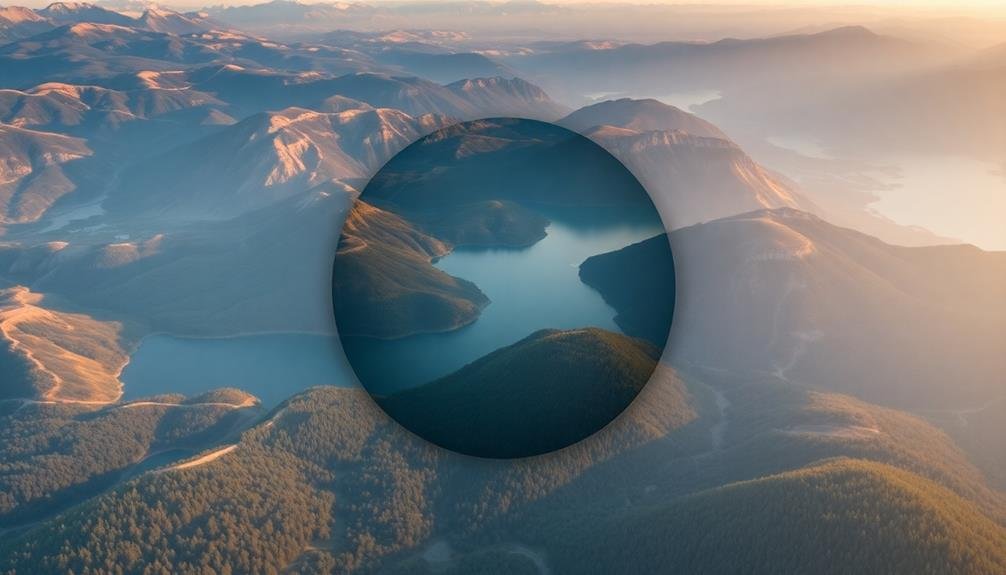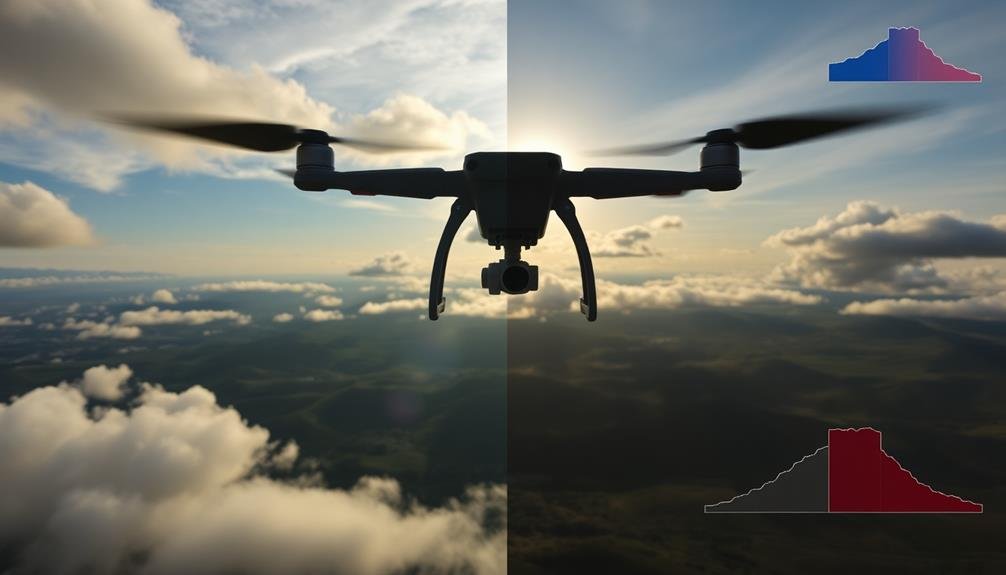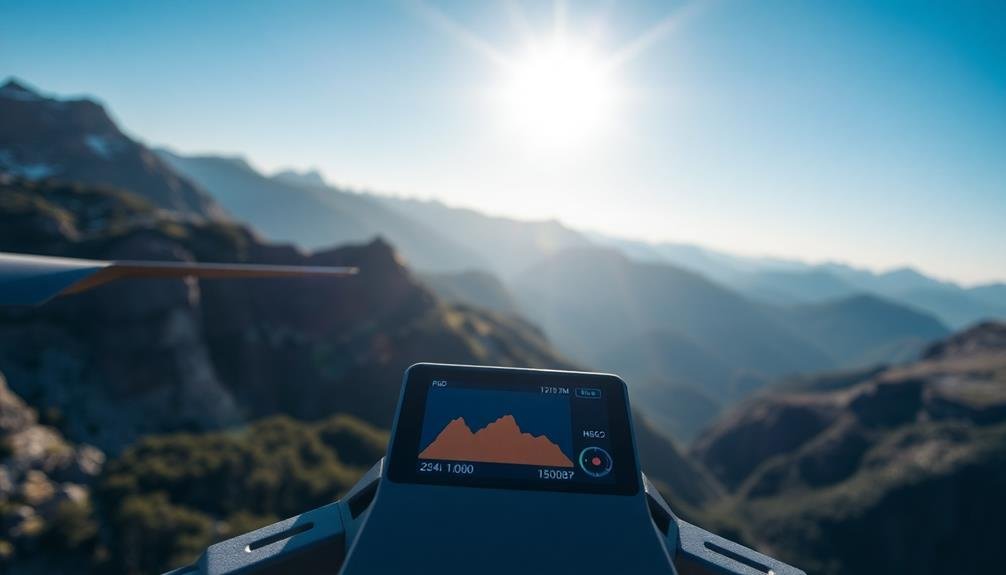To excel in aerial photography, master these three essential camera metering tips. First, use matrix metering for balanced exposures in varied lighting conditions, especially for landscapes. Second, employ spot metering to focus on specific elements in high-contrast scenes, ensuring accurate exposure of your main subject. Third, utilize exposure compensation to handle extreme brightness variations, adjusting for bright skies or shadowy terrain. Remember to experiment with different metering modes and compensation values as lighting changes. By mastering these techniques, you'll capture stunning aerial shots that truly stand out. There's always more to learn about perfecting your aerial photography skills.
Key Takeaways
- Use matrix metering for balanced exposure in varied aerial scenes, especially landscapes and cityscapes.
- Switch to spot metering for high-contrast scenes or to capture specific elements accurately.
- Apply exposure compensation to handle bright skies or dark landscapes, typically +1 to +2 stops for clouds.
- Utilize the histogram to ensure proper exposure and avoid clipping important details in aerial shots.
- Practice switching between metering modes quickly to adapt to changing lighting conditions during flight.
Understand Matrix Metering

Matrix metering, also known as evaluative metering, is a sophisticated camera metering system that divides the frame into multiple zones. It analyzes these zones for brightness, contrast, and color to determine the ideal exposure for your aerial shots. When you're shooting from above, matrix metering can be particularly useful as it considers the entire scene, including the sky and ground.
You'll find that matrix metering works well in most aerial photography situations, especially when you're dealing with varied lighting conditions. It's particularly effective when you're capturing landscapes or cityscapes from the air, as it balances exposure across different elements in the frame.
However, it's important to understand its limitations. In high-contrast scenes, such as when you're shooting directly into the sun or over reflective water bodies, matrix metering might struggle to provide the perfect exposure. In these cases, you may need to use exposure compensation or switch to a different metering mode.
To get the most out of matrix metering, familiarize yourself with your camera's specific implementation. Some advanced systems can recognize faces or prioritize certain areas of the frame, which can be beneficial for aerial portraits or specific compositional styles.
Master Spot Metering Techniques

In contrast to matrix metering, spot metering focuses on a small area of your frame, typically 1-5% of the viewfinder. This technique is particularly useful in aerial photography when you're dealing with high-contrast scenes or want to capture specific elements accurately.
To master spot metering, start by identifying the most important part of your aerial composition. It could be a bright cloud, a dark shadow, or a mid-tone element. Place your camera's spot meter on this area and adjust your exposure accordingly.
Remember, the camera will try to make this spot appear as middle gray, so you'll need to compensate if you're metering on very bright or dark subjects.
For aerial landscapes with dramatic lighting, try the Zone System approach. Meter the brightest and darkest areas separately, then set your exposure to capture the full range of tones.
In situations where you're photographing a subject against a bright sky, spot meter on the subject to prevent silhouettes.
Practice switching between matrix and spot metering quickly. You'll often encounter rapidly changing lighting conditions in aerial photography, and being able to adapt your metering technique on the fly is essential for capturing stunning images.
Utilize Exposure Compensation

While spot metering offers precise control, exposure compensation remains an essential tool for aerial photographers. You'll often encounter scenes with extreme brightness variations, where even spot metering mightn't capture the perfect exposure. That's where exposure compensation steps in.
To utilize exposure compensation effectively, start by evaluating your scene. If you're shooting bright clouds or snow-covered landscapes, you'll likely need to increase exposure by +1 or +2 stops.
Conversely, when capturing dark subjects like dense forests or shadowy urban areas, decrease exposure by -1 or -2 stops.
Don't hesitate to experiment with different compensation values. It's better to slightly overexpose than underexpose, as you can recover more detail from highlights than shadows in post-processing.
Use your camera's histogram to guarantee you're not clipping important details.
Frequently Asked Questions
How Does Altitude Affect Metering in Aerial Photography?
As you increase altitude, your camera's metering becomes less accurate. You'll need to adjust for larger areas of sky and changing light conditions. Higher altitudes often require exposure compensation to avoid underexposed images.
What's the Best Metering Mode for Photographing Reflective Surfaces From Above?
For photographing reflective surfaces from above, you'll want to use spot metering. It'll help you accurately measure the light on specific areas, avoiding overexposure caused by bright reflections. Alternatively, try matrix metering for more balanced results.
How Do Different Weather Conditions Impact Aerial Photography Metering?
Weather greatly affects your aerial metering. You'll need to adjust for bright skies, overcast conditions, or hazy atmospheres. Sunlight reflections can trick your meter, so you should be prepared to compensate manually in challenging lighting situations.
Are There Specific Metering Considerations for Drone Photography Versus Manned Aircraft?
You'll face unique metering challenges with drones. They're more sensitive to wind and vibration, affecting exposure. You'll need to adjust for their smaller sensors and limited dynamic range compared to manned aircraft cameras.
How Does Image Stabilization Affect Metering in Aerial Photography?
Image stabilization doesn't directly affect metering, but it can impact your exposure choices. You'll be able to use slower shutter speeds, which might influence your aperture and ISO settings for proper exposure.
In Summary
You've now mastered the essentials of camera metering for aerial photography. By understanding matrix metering, mastering spot metering techniques, and utilizing exposure compensation, you'll capture stunning aerial shots with perfect exposure. Remember, practice makes perfect. Don't be afraid to experiment with different metering modes and settings. As you gain experience, you'll intuitively know which method works best for each unique aerial scenario. Keep shooting, keep learning, and watch your aerial photography soar to new heights.

As educators and advocates for responsible drone use, we’re committed to sharing our knowledge and expertise with aspiring aerial photographers.




Leave a Reply